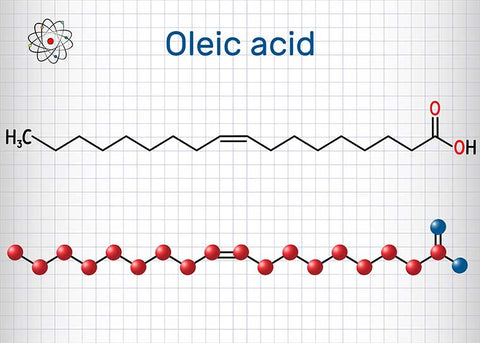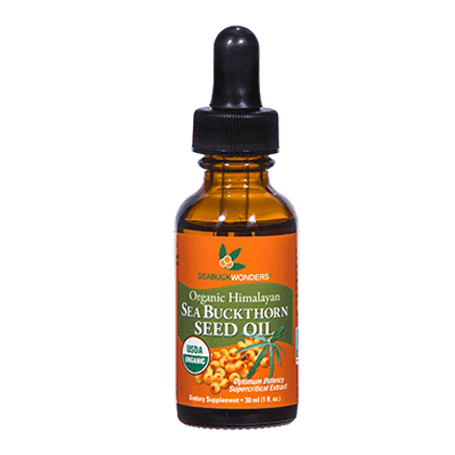Why are Linoleic and Oleic Acid Important and How to Use Them?
- Home /
- Wonders of Sea Buckthorn blog
- Why are Linoleic and Oleic Acid Important and How to Use Them?
By Admin Email , published Dec 29, 2019
Sea buckthorn oil is best known for its omega 7 content. An important factor that is often overlooked is that sea buckthorn seed oil has an almost perfect balance of linoleic acid (omega 6), oleic acid (omega 9), and other important EFAS like omegas 3 and 9.
Linoleic acid is an essential fatty acid, meaning that the body cannot make it on its own. Though oleic acid is made in the body, sometimes the levels within the skin can be off balance. These fatty acids play important roles throughout our bodies, with special focus on the cell membranes.
The Lipids in Our Skin
Our epidermis is a complex organ that uses a network of different lipids to function properly. Lipids are organic compounds made of fatty acids or derivatives of fatty acids. They’re made up of waxes and natural oils. The lipids found in the skin include sebaceous lipids, wax esters, squalene, diglycerides, cholesterol esters, sterol esters and of course, free fatty acids.
Oleic and linoleic acid are crucial for skin health, so much so that many common skin issues are related to imbalanced levels of the two. They are important in skincare ingredients. Having a good understanding of how they work will help you choose the best products for your skin type.

Linoleic Acid
Of the different kinds of polyunsaturated fatty acids present in the skin, linoleic acid (omega 6) is the most dominant. Omega 6 is a part of other lipids found in the ecosystem of the epidermis. Lipids called sphingolipids combine with fatty acids to create ceramides.
Ceramides are one of the most important components of the outer layer of human skin. Ceramides make long sheets and it’s thought that they’re the main reason the outer layer of skin has important protective properties.
Linoleic acid enables an important protective function, and there are high levels of it found in ceramides. The network of ceramides, powered by linoleic acid, prevents the loss of water in the cells and protects from outside pathogens.
Research shows that omega 6 can be especially helpful for sensitive skin and skin that suffers from inflammation related issues.

How Omega 6 Works in Skin care
We know that linoleic acid is important in our bodies and the composition of our skin. While science is still discovering much about the full function of fatty acids in skin, there is mounting evidence that linoleic acid (omega 6) plays a very important role in particular.
One study focused on acne sufferers showed that subjects with acne also had low levels of linoleic acid on the surface of their skin. Other studies suggest that having a balanced amount of omega 6 and omega 3 could be the key to better balanced skin.
Sea buckthorn seed oil has a balanced ratio of omega 6 and omega 3. Another sign that sea buckthorn seed oil could be appropriate for acne prone skin is its low level on the comedogenic scale. Because it ranks as a number 1, it can be considered non-comedogenic, meaning it’s not likely to clog pores.
Oleic Acid
Oleic acid is also called omega 9, it is a monounsaturated fatty acid, and it’s actually the most common fatty acid found on earth. Like omega 6, it can be found in many of the components that make up skin, like in wax or cholesterol esters.
On its own, oleic acid has a penetrating effect, meaning that it can break through different cellular layers in the body. Studies of isolated oleic acid imply that the fatty acid on its own could be disruptive or irritating for skin.
However, omega 9 is almost never isolated when it comes to natural oils and skincare. It’s commonly found in plant-based oils, and is usually paired with other fatty acids, like linoleic acid.
Natural oils that have high levels of oleic acid also have higher numbers on the comedogenic scale. Some oils that are especially high are coconut oil or olive oil. While these ingredients sound like a recipe for irritation, some plant oils have a healthy balance of oleic acid.
Sea buckthorn oil, especially the seed oil, has a nearly perfect ratio of oleic acid, linoleic acid, and even omega 3. The oleic acid in sea buckthorn seed oil is beneficial because it helps to deeply penetrate to help nurture skin cells.
In balanced oils like sea buckthorn seed oil, omega 9 can have hydrating and soothing properties for skin.

How to Use Sea Buckthorn Seed Oil on Your Face
We sell two versions of sea buckthorn seed oil: a dropper bottle of pure oil, and a gel capsule product. For imbalanced skin, or dryness, we always recommend doing an external procedure combined with an internal procedure. Using sea buckthorn oil as an internal supplement can produce great results. That’s where our “beauty from the inside out” slogan comes from.
Internal use of sea buckthorn oils in general can help cellular health and reintroduce moisture throughout the body, including skin. Pure sea buckthorn seed oil makes a good topical treatment. It also makes a great companion for other ingredients in our skincare line.
After washing and gently drying your skin, you can massage one drop of pure sea buckthorn seed oil into your face, focusing on areas that need it most. Because everyone’s skin differs, you might want to use more than one drop. Start with one drop and add more as needed.

For Dry or Oily Skin
Dry skin types will quickly absorb sea buckthorn seed oil, but oily skin types may also benefit from the stability bringing qualities of sea buckthorn seed oil, rich with linoleic acid. Those with sensitive and oily skin will want to try treatments with small amounts of sea buckthorn seed oil.
Start with one drop, massage it in and add more as needed. After about twenty minutes, use a gentle cleanser to remove excess oil on the skin. It should be enough time for your skin to absorb nutrients from the oil. Some people like to leave in on for longer or may even be able to use it as a serum-base for under their daily moisturizer (for dry skin types).
We recommend experimenting to find the perfect regimen for your skin type, always starting with a very small amount. For those who simply aren’t comfortable using pure oil on their skin (you aren’t alone), we have crafted our Sea Buckthorn Facial Cream.
It’s light but deeply moisturizing and is designed to be balancing for all skin types- even sensitive. This product contains sea buckthorn seed oil and sea buckthorn berry oil along with other gentle ingredients.
Dry skin types might want to do a layer of seed oil and once its absorbed, another layer of Facial Cream, to help seal in moisture throughout the day. The key is finding the right balance of topical treatments and oral supplementation for your situation.
Learn how to use sea buckthorn berry oil on your face here.

Sea Buckthorn Provides a Host of EFAs
Linoleic and oleic acid are incredibly important to skin health and creating skincare products. While most plant-based oils contain these fatty acids, sea buckthorn oil has a perfectly balanced ratio of the two.
We only discussed these two components, but sea buckthorn oil has other important fatty acids, including omega 3, omega 7, and palmitic acid, which plays an important role for skin function. Because of its perfect balance of fatty acids and antioxidants, sea buckthorn oils can be extremely helpful for supporting many skin types.












